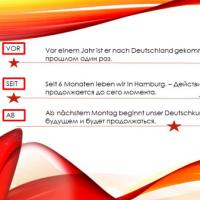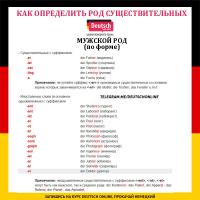Features of reflecting standard deductions for personal income tax. Features of reflecting standard deductions for personal income tax How to add a child’s deduction in 1c
Current standard deductions and to whom they are available.
The organization must provide standard tax deductions to its full-time employees, as well as those working under civil contracts, if such an employee submits an application for a deduction.
Standard tax deductions reduce the amount of income subject to personal income tax at a rate of 13%.
If an employee works in several organizations, then the deduction is provided only in one of them. In this case, the employee decides independently which organization he will receive the deduction from.
Until January 1, 2012, all employees were provided with a personal tax deduction in the amount of 400 rubles, but it has now been cancelled.
Since January 2013, employees have the right to deductions for minor children(or full-time students under 24 years old) in the amount of 1,400 rubles for the first and second child, and 3,000 rubles for the third child.
The child deduction applies until the end of the year in which the child reaches the age of 18 (or 24 years).
Starting from the month in which the employee’s total annual income exceeded 280,000 rubles, deductions for children are not provided.
A double “children's” deduction is provided to a single unmarried parent if he is officially recognized as the only one or is a widow (widower).
There are also personal deductions of 500 and 3,000 rubles, valid for certain categories of workers.
The following have the right to deduct 500 rubles in accordance with clause 1.clause 1 of Article 218 of the Tax Code of the Russian Federation:
- Heroes of the Soviet Union or Russian Federation;
- awarded the Order of Glory of three degrees;
- disabled since childhood;
- disabled people of groups I and II.
The following have the right to a deduction of 3,000 rubles:
- victims at nuclear facilities as a result of radiation accidents and nuclear weapons tests;
- disabled people of the Great Patriotic War.
The procedure for entering standard deductions in 1C Salary and Personnel Management.
To enter standard tax deductions for an employee, you need to open the “Individuals” directory (link on the “Enterprise” and “Human Resources” desktop tabs or through the main menu of the program -> “Enterprise” -> “Individuals”).
We find the required employee, open the directory element form. In the top panel, click on the “Personal Income Tax” button.

The personal income tax data entry form opens.
Entries are entered into the “Right to personal standard deduction” table if the employee has the right to a deduction of 500 or 3,000 rubles.
In the table “Eligibility for standard deductions for children,” data on deductions provided for children is entered.

Using the “Add” button, enter a new line. In the “Period from” column, the system itself inserts the date corresponding to the beginning of the month in which we enter the data. If necessary, the date can be adjusted.
Attention! Since the personal income tax deduction code for the second child is different from the first, despite the fact that the deduction amounts are the same and the “Number of Children” column is provided, it is more correct to enter each child in a separate line.
Below is the table “Application of deductions”. Here you must enter a line with the start date of the deduction and the organization in which the deductions are applied.
If the database keeps records for several organizations, and the employee goes to work for one of these organizations, then confusion may arise in the application of deductions, since there is only one individual in the database (and there are several employees). In this case, it is important to add a line to the “Application of Deductions” table indicating the other organization and the period from which the deductions are applied in the other organization. The information entered in the table “Eligibility for standard deductions for children” is left unchanged.
Non-standard situations with standard deductions.
Letter of the Ministry of Finance dated 06/07/2013 No. 03-04-05/21379 explains the issue of providing a deduction for a child to a woman whose spouse has two (or more) children from her first marriage, and for the woman the child is the first.
If the children from the spouse’s previous marriage are supported by him (regardless of whether they live with him), then his wife also has the right to a deduction in the amount of 3,000 rubles, i.e. like a third child.
I myself have two children, and my husband has two children from his first marriage.
Thus, for the first child I am given a deduction with code 114/108 (for the first child), and for the second - a deduction with code 116, as for the third child, despite the fact that for me this child is the second.
And the deduction entries in my case will look like this:

Thus to the program 1C Salary and Personnel Management 8 are introduced information about standard personal income tax deductions.
In the accounting policy, you can configure the methods for calculating standard deductions. To set up deductions, in the Settings section, select Organizational details, go to the Accounting policies and other settings tab and click on the Accounting policies link at the bottom of the form.
You can set the use of tax deductions in 1C ZUP 8.3:
- Cumulative total – all deductions and income for the year are analyzed. If for a certain period an employee has no income, but the employment relationship does not terminate, then at the moment income appears for all previous periods in which the income was zero, deductions will be provided. But not more than the amount of income generated;
- Within the limits of monthly income - income for the month is analyzed; if there is no income, there is no deduction:
How to set up the procedure for applying standard tax deductions in 1C ZUP in accordance with the law is discussed in our video lesson:
You can register the right to deduction in 1C ZUP 8.3 in the Taxes and Contributions section, then Application for Deductions and select Application for Deduction for Personal Income Tax:

You can also go to the Income Tax hyperlink from the employee’s card and select the Enter a new application for standard deductions link:

- Employee – filled in automatically if you enter a document from the “Employees” directory;
Important! It is impossible to enter several identical deductions for one period for one person, even if he works in several positions. This is controlled by individuals.
- Month – the month from which deductions are applied;
- Fill out the required deductions. In the document, it is possible to immediately issue a deduction for children in combination with a personal deduction or one of the types of deduction:

Deductions for children
When registering deductions for children in 1C ZUP 8.3, you must check the box in the document in the Change deductions for children field.
In the tabular part:
- Deduction – select the required deduction from the proposed list. The table displays the code line by line, and the adjacent column is automatically filled in with the deduction decoding;
- Provided by – the last month of the year of deduction expiration is indicated. Let’s say when a child turns 18;
- Documents – a document providing the basis for providing a deduction, for example, a certificate of education or birth certificate, as well as an employee’s statement:

Important! In 2016, a deduction for children is provided until the taxable income does not exceed 350,000 rubles. Until 01/01/2016 the limit was 280,000 rubles.
The amount of personal income tax deductions, the income limit, as well as the date from which they are valid, can be viewed in the information register Amount of personal income tax deductions using the All functions menu item:

Personal deduction
To register a personal deduction in 1C ZUP 8.3, you must check the box Change personal deduction and select the required deduction code.
Important! Preferential deductions do not depend on income. And only one maximum deduction is provided.
It is also necessary to enter supporting documents in the Document confirming the right to personal deduction field:

Standard deductions for non-year-to-date employment
To correctly calculate deductions in 1C ZUP 8.3 when finding employment in the middle or end of the year, you must enter income from your previous place of work.
These incomes are entered from the employee’s card: section Personnel - directory Employees - click on the link Income Tax - further Income from the previous place of work:

For each month from the beginning of the year until employment, enter taxable income according to the 2-NDFL certificate:

Current deductions can be viewed in the employee’s card using the Income Tax hyperlink. You can also submit new documents to change or terminate the provision of standard deductions here:

To correct the application for standard deductions in 1C ZUP 8.3, you must use the link Correct the application for standard deductions. New change documents are entered using the Enter a new application for standard deductions link:

In the new document, you can change deductions or add new standard deductions:

When calculating wages in 1C ZUP 8.3, the personal income tax tab automatically displays all tax deductions that apply in the month of accrual. More detailed information on the calculation can be viewed via the link. For more details, see the Personal Income Tax Register:

This register describes what standard deductions an employee is entitled to:

As well as calculation of the tax base taking into account deductions:


Important! The amount of taxable income can be viewed in the personal income tax register, but it must be taken into account that the calculation does not display income from previous jobs, but when calculating deductions, they participate and are indicated in paragraph 3:

Termination of standard deductions in 1C ZUP 8.3
When dismissing an employee, in 1C ZUP 8.3 you must enter a special document Cancellation of standard personal income tax deductions. This document can be created from the Taxes and Contributions – Application for Deductions section or from an employee’s card in the same way as registering deductions, only by selecting the Stop providing all standard deductions link.
Important! Also, the document Cancellation of standard personal income tax deductions must be entered if the employee has written an application to terminate deductions in connection with receiving them at another enterprise.
Filling out the document:
- When you select an employee, the document is automatically filled in with all available standard deductions for the employee. If created from an employee card, the document is automatically completely filled out;
- You only need to set the month from which all standard deductions stop:

Hello dear blog readers. We started a detailed conversation about personal income tax accounting in 1C ZUP and looked at the simplest example, which presented the full cycle of personal income tax accounting (by the way, you can read about the formation of 6-personal income tax in the article). In that example, personal income tax was calculated using the “Payroll” document. Today I will tell you in what other documents it is possible to calculate personal income tax, and we will also talk about what parameters are available in the 1C Salary and Personnel Management program for setting up personal income tax accounting, why they are needed and where they are located. In particular, we will discuss personal income tax deduction settings, as well as possible options for choosing the status of an individual for personal income tax accounting purposes ( resident, non-resident, highly qualified foreign specialist and others). In this article we will look at two examples:
- In the first one, we will work with the deduction settings - the employee has 4 deductions;
- In the second example, let's see how the program reflects and compensates for excessively withheld personal income tax when the taxpayer's status changes.
✅
✅
So, in the previous publication an example was presented where an employee had only one planned type of accrual, which was calculated in the document "Payroll" and personal income tax from this accrual was also calculated in the same document. But in 1C ZUP there are also a number of accrual documents that provide for the calculation of personal income tax. Let me first list all these documents:
- – “Payment” tab;
- – tab “Calculation of sick leave” -> “Personal income tax”
- – “NDFL” tab
The ability to calculate personal income tax in these documents appeared not so long ago. Previously, personal income tax was calculated only in document "Payroll" and that's why it should have been a last resort so that all accruals for the month are taken into account to correctly calculate personal income tax. This recommendation should still be followed now. Since most of the accrual documents still do not support the independent calculation of personal income tax, the amounts for these documents will be taken into account when calculating personal income tax in the final document “Payroll.” These include the following documents:
- Employee bonuses;
- Registration of downtime of employees of organizations;
- Calculation of severance.
Setting up personal income tax deductions in 1C ZUP
✅
✅ CHECKLIST for checking payroll calculations in 1C ZUP 3.1
VIDEO - monthly self-check of accounting:
✅ Payroll calculation in 1C ZUP 3.1
Step-by-step instructions for beginners:
Now let's talk about how the program sets up accounting for standard tax deductions. First, let me remind you what a tax deduction is. A tax deduction is a certain amount that reduces the tax base, i.e. not subject to personal income tax. In essence, this is a benefit established by the state for a certain circle of citizens. This is where I started talking about standard tax deductions. These include:
- 1400 rub. – for each child (for the first and second child) – code 114/108 (for the first child) and code 115 (for the second child);
- 3000 rub. – for the third and each subsequent child – code 116;
- 3000 rub. – for each disabled child of group I or II – code 117/109;
- 500 rub. - for persons with state awards: in particular, for Heroes of the Soviet Union, Heroes of Russia, for those awarded the Order of Glory of three degrees and many others - code 104 (in the ZUP this deduction is considered a personal standard deduction);
For those who are just starting to get acquainted with the theory of payroll calculation, accounting for personal income tax and deductions, I will give a small example. Let's assume that employee Stepanova has four children, i.e. she has the right to 2 deductions of 1400 rubles each. (code 114 and 115) and 2 deductions of 3000 rubles each. for the third and fourth child (code 116). She also has a salary of 30,000 rubles. Under these conditions, personal income tax (13%) will be calculated using the following formula: (30,000 – (1,400 + 1,400 + 3,000 + 3,000)) * 13% = 21 200 * 13% = 2,756 rub. Thus, the tax base will not be the entire salary, but the amount reduced by the amount of deductions due.
Let's now implement this example in the 1C ZUP program. To fill out information about an employee’s right to standard deductions, the program uses the “Data Entry for Personal Income Tax” form. It can be accessed from the “Employees of the Organization” directory form.
You can also fill in the Reason field, but this is not required. If the Deduction is terminated, the Date and status are indicated "do not apply".

In our example, the employee does not have personal deductions, so we will leave this tabular part empty.
The second tabular part in this form is called "Eligibility for Standard Deduction for Children". We will fill out this form for employee Stepanova. Let me remind you that, according to the conditions of the example, she has four children and, accordingly, can use the following deductions:
- 114/108 – for the first child 1,400 rubles;
- 115 – for the second child 1,400 rubles;
- 116 – for the third and fourth child, 3,000 rubles each. for everyone;
The fields in this tabular section are approximately the same. The only difference is that you can indicate the number of children (we use this option for deduction code 116) and indicate the date until which the deduction is valid, if this is known in advance (we use this for deduction 114/108). You can also stop deduction by entering a separate line, indicating the value “Do not apply”, deduction code and date. The screenshots show both options.


Another tabular part in this form is called "Application of deduction".
And this you need to do it even if you have one organization in the program, otherwise deductions will not be taken into account.

I would also like to draw your attention to the fact that there is another bookmark in this form. Let me remind you that the standard tax deduction is applied until the employee’s cumulative income from the beginning of the year does not exceed 280,000 rubles. Therefore, if an employee does not join the organization from the beginning of the year, then for him you should indicate the income that he had in the previous or previous organization from the beginning of the year. This data will only be taken into account to track the RUB 280,000 limit. These amounts will not affect the calculation of average earnings in any way.
In our case, the employee was hired at the beginning of the year and therefore bookmark “Income from previous jobs” leave it blank.

Taxpayer status for personal income tax
✅ Seminar “Lifehacks for 1C ZUP 3.1”
Analysis of 15 life hacks for accounting in 1C ZUP 3.1:
✅ CHECKLIST for checking payroll calculations in 1C ZUP 3.1
VIDEO - monthly self-check of accounting:
✅ Payroll calculation in 1C ZUP 3.1
Step-by-step instructions for beginners:
Taxpayer status in 1C ZUP can be established using the form “Data entry for personal income tax”. It can be opened from the form of the “Employees” directory element in the “Status” field. There are 5 options to select the status:
- Resident
- Non-resident
- Highly qualified foreign specialist
- Participant in the program for the resettlement of compatriots
- Refugee or who has received temporary asylum on the territory of the Russian Federation - appeared in the release of ZUP 2.5.85

There are explanations in the program for each option, so I will only focus on the features of reflecting the situation when an employee’s status changes in the middle of the year. As you can see, in addition to the switches themselves, the form has a field where the period is set. Those. this indicator is periodic. Let's look at a similar situation.
An employee who is a foreign citizen and at the time of hiring (01/10/2014) resides in the Russian Federation is hired by the organization. less than 183 calendar days. Therefore, he is given the status "Non-resident". As a result, personal income tax for January and February is calculated at a rate of 30%.

It turns out that the employee’s personal income tax for January and February is 18,000 = 9,000 + 9,000 = 30,000 * 30% + 30,000 * 30%.
In March, the deadline comes when a foreign citizen’s stay on the territory of the Russian Federation will exceed 183 days. Therefore he acquires the status "Resident". In this case, in 1C it is necessary to change the employee’s status indicating the month in which he received the corresponding status and this will be saved in the history of changes.

As a result, the employee’s personal income tax will begin to be calculated at a rate of 13% from March. But this is not the only change that will occur. When calculating personal income tax for March, the tax for January and February will be recalculated at a rate of 13%. Negative amounts will be calculated for January and February: 30,000 * (13%-30%) = -30,000 * 17% = - 5100; -5,100 *2 = -10,200 rub. (excess withheld for 2 months).

Refunds of excess withheld amounts will be made from the tax calculated in March: RUB 3,900. Those. in March, the employee will receive his full salary without personal income tax withholding. However, personal income tax for March is not enough to fully compensate for the excessively withheld amount and therefore in the pay slip for March in the line “including: excessively withheld personal income tax at the end of the period” we will see the figure 6,300 = 10,200 (the amount of excess withheld at the beginning of March) - 3,900 (returned from the March personal income tax).

Please note that this debt in the amount of 6,300 rubles. Although it is listed as a debt for the organization, it will not affect the amount of salary payable. The employee will be paid 30,000, not 36,300.
Thus, the return of excessively withheld personal income tax to the employee will be carried out in the next two months, at the expense of the calculated personal income tax in these months. I hope I explained this mechanism clearly.
In this example, we have a rather simple situation: the employee’s status changed at the beginning of the year and there is time to compensate for personal income tax due to the following months. But it may turn out that the employee changes status, for example, in November and simply there won't be enough time until the end of the year to compensate the entire excess amount withheld. In this case, the program will not carry over this debt to the next year. The employee should independently contact the tax office and it will be the one who will return the excess withheld funds to him. In this case, you should not enter the document “Personal income tax return”, since the tax agent (the employer is the tax agent for the payment of personal income tax) does not have the right to return personal income tax to the employee, but can only offset the overpaid amounts against the following months (I talked about this a little higher with an example).
That's all for today!
To be the first to know about new publications, subscribe to my blog updates:
When purchasing real estate, employees have the right to submit an application to their organization for a property deduction. About how to process this deduction in the 1C Accounting 8 program, ed. 3.0 we will look at in this article.
To receive a deduction in his organization, an employee must submit an application along with a notification issued by the Federal Tax Service. Based on the documents presented, the program issues a property deduction.
To complete this task, we need the “Salaries and Personnel” tab. In the “Personal Income Tax” section, find the item “Application for deductions” and click on it. In the application log that opens, click the “Create” button and then select “Notification of the right to property deduction.”
In the new notification, we need to select the employee for whom the deduction is issued. Then we need to indicate the tax period and the period from which this deduction will be applied.
Below you should indicate the amount of the deduction and enter data on the right to deduct the notification: its number, date and the Federal Tax Service on which the employee received the notification.
After we post the notification, it will be stored in the document log for deductions.
Thus, when we pay wages to an employee who has the right to a property deduction, the program will automatically take it into account when calculating personal income tax. The deduction will be carried over to subsequent months until it is fully used.
You can also view deductions in the program using a universal report. To do this, use the “Reports” tab, then go to the “Standard Reports” section and select “Universal Report” there. In it we need to indicate the period and select the accumulation register “Property deductions (NDFL)”. If necessary, you can customize the report by clicking on the “Show settings” button, and then on “Generate”. As a result, a report will be created that will reflect changes in property deductions for each month.
Let's set it up. Let's connect. We'll fix it. Let's find error 1c.
Good afternoon, I couldn’t write to the salary section of the forum for some reason the new topic button doesn’t appear. In 1C Salary and Personnel Management, when adding standard deductions for children, the size of the deduction is automatically set equal to the size of the salary; if manually corrected, the situation does not change, and personal income tax is not charged. How to set up standard deductions for calculating employee salaries.
Good afternoon,
version of 4 numbers - voice it out.
They are constantly changing things and correcting mistakes.
In order for personal income tax to be calculated in the program taking into account the use of standard tax deductions, the right of an individual to standard tax deductions must be specially registered in the program.
For the initial entry and subsequent modification of information about standard tax deductions of an individual (personal and “for children”), which will be taken into account when calculating personal income tax, the document is intended Application for personal income tax deductions. The document can be entered from the document journal Applications for deductions(chapter Taxes and contributions – Applications for deductions – Create button – Application for deductions for personal income tax), as well as from the employee’s card (section Personnel – Employees – link Tax on – link Enter a new application for standard deductions).
In chapter Deductions for children checkbox Change deductions for children is installed by default. An employee is entitled to several different types of child deductions. In this regard, the tabular section lists all deductions for children that should be applied from the specified month of the tax period using the button Add. Each individual deduction (individual child) must have a separate row in the table. In each such line, indicate:
- in a collumn Deduction– standard child tax deduction code according to the directory Types of personal income tax deductions. For convenience, the choice is limited only to deductions for children; other types of deductions (personal, etc.) are not offered for selection;
- in column P provided by (inclusive)– the last month of the year until (inclusive) the selected deduction is provided (December of the current tax period is indicated by default). If necessary, it can be changed, for example, at the end of the year in which the child turns 18 years old. Indication of the month is mandatory; it cannot be left blank;
- in a collumn Document, confirming the right to a deduction, provide information about the document confirming the right to the deduction provided
Information about the current standard tax deductions provided to an employee can be viewed and also changed in his card (section)
.
When determining the possibility of providing an individual with standard tax deductions, not only the income accrued to him in this organization, but also all income from the beginning of the tax period received from previous places of work must be taken into account.
Entering information about income from a previous place of work is carried out in the form Income from previous place of work, which opens via the link of the same name from the section Personnel – Employees – link Income tax
Monthly salary calculations and personal income tax calculations are made using the document Calculation of salaries and contributions(chapter Salary – Payroll and contributions or section Salary – Create – Payroll and contributions V). By button Fill The document is filled out and fully calculated (Fig. 6). At the same time, in the tabular part on the tab Accruals lines are entered for all types of accruals assigned to employees as planned.
 Russian disaster in Tuva
Russian disaster in Tuva The resource-rich region is in disrepair and the Russians are unwelcome guests.
The resource-rich region is in disrepair and the Russians are unwelcome guests. Oliver Stone is making America great again - Americans' reaction to a conversation between smart people
Oliver Stone is making America great again - Americans' reaction to a conversation between smart people How long can cottage cheese casserole be stored in the refrigerator?
How long can cottage cheese casserole be stored in the refrigerator? Because there's a comma. Because of. A comma is not placed at the beginning of a sentence
Because there's a comma. Because of. A comma is not placed at the beginning of a sentence Temporal prepositions VOR - SEIT - AB
Temporal prepositions VOR - SEIT - AB Gender of German nouns
Gender of German nouns